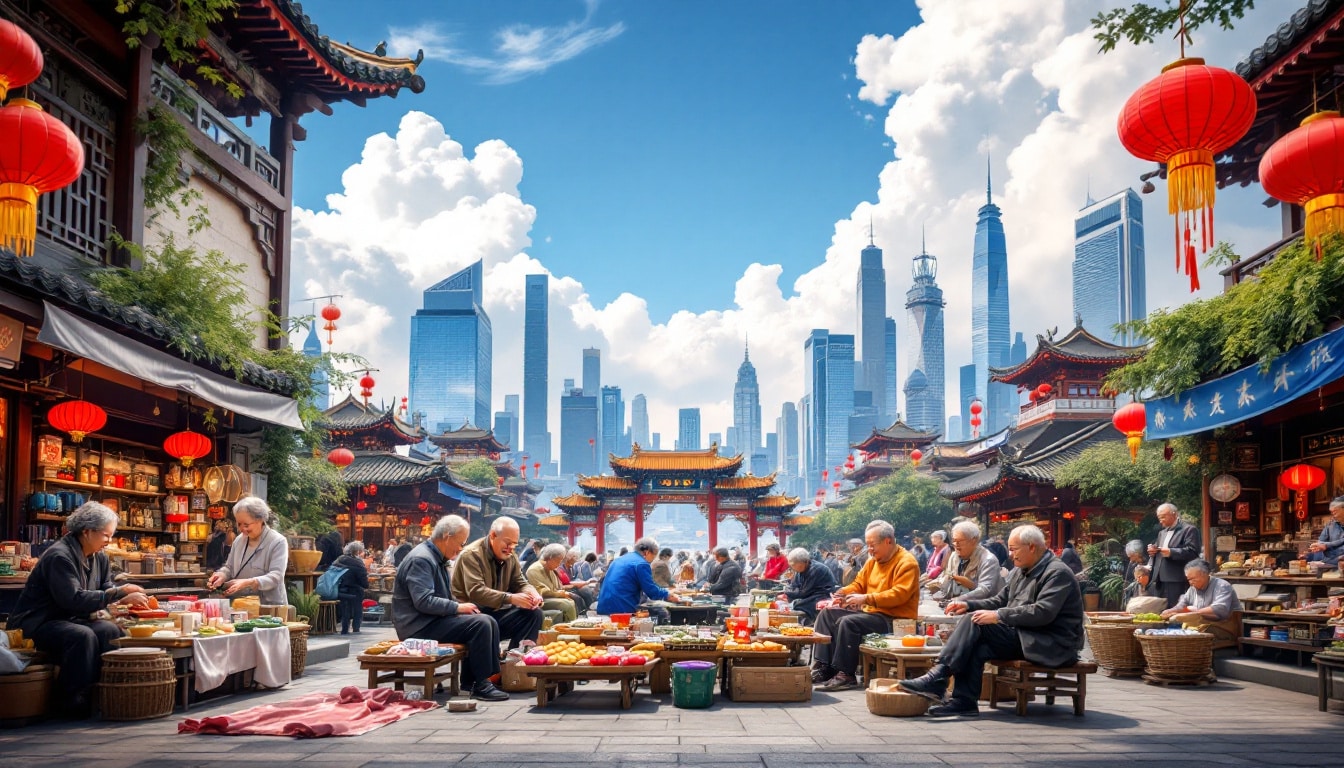China is navigating turbulent economic waters in 2024. With GDP growth falling to 5%, the country is facing unprecedented challenges. Yet, a glimmer of hope emerges on the horizon.
The silver economy is positioning itself as an essential pillar to counteract the aging population in China. As traditional sectors show signs of slowing, services dedicated to seniors are experiencing rapid expansion. This dynamics offers new opportunities in cultural tourism and adapted technologies. At the same time, government initiatives aim to strengthen this promising sector, thus ensuring sustainable growth.

In the midst of global economic challenges, China is resolutely turning to the silver economy to stimulate its growth. Facing an aging population, this expanding sector meets the specific needs of seniors while opening new economic opportunities. But how could this initiative transform the Chinese and global economic landscape?
What is the silver economy and why is it crucial for China?
The silver economy refers to the entire set of economic activities related to the needs of the elderly. In China, this concept holds particular significance due to the rapid aging of its population. According to the Chinese Research Center on Aging, the silver economy in 2024 represents a significant value, with sales of services and goods dedicated to seniors rising sharply.
This trend is fueled by a growing demand for health services, suitable housing, leisure activities, and technologies that facilitate the lives of the elderly. The silver economy thus provides a fertile ground for innovation and the development of new markets, while addressing the social challenges posed by demographic aging.
To learn more about the importance of this economy, check out this article that explores the discussions around the silver economy during the upcoming sessions in China.
What are the main sectors of the silver economy in China?
The silver economy in China is divided into several key sectors that meet the varied needs of seniors. Among them, adapted cultural tourism stands out as a rapidly growing area. Initiatives aimed at developing tourism offers specific to the elderly stimulate not only the travel sector but also related industries such as hospitality and transportation services.
Furthermore, innovative technologies play a crucial role in the development of the silver economy. Start-ups are proliferating to provide digital solutions that facilitate the lives of seniors, whether through home care, security devices, or adapted communication platforms. This dynamic is particularly evident in the optimization of the silver economy through in-depth exchange sessions, as highlighted in this article.
What challenges does the silver economy face in China?
Despite its promising potential, the silver economy in China must overcome several major challenges. One of the main obstacles is the need for deep structural reforms to ensure sustainable growth. One-time stimulus measures, while necessary, are not sufficient on their own to radically transform the market.
Moreover, international competition in the senior technology sector is becoming increasingly intense. China must constantly innovate to remain competitive, especially in light of rapid advancements by other nations in this field. This paradox manifests in the need to become a global leader in clean energy while effectively managing the challenges related to manufacturing and environmental sustainability.
To delve into current challenges, this article offers a detailed analysis of Chinese strategies in response to demographic aging.
How is China innovating to support the silver economy?
Innovation is at the heart of China’s strategy to support the silver economy. The country is investing heavily in research and development to create solutions tailored to the needs of seniors. Technologies such as artificial intelligence, robotics, and the Internet of Things are being integrated into health services, elderly residences, and leisure platforms.
Additionally, the Chinese government encourages public-private partnerships to accelerate innovation in this sector. Tech companies collaborate with health institutions and community organizations to develop products and services that enhance the quality of life for the elderly.
To discover how China is innovating in response to the aging of its population, refer to this article.
What is the impact of the silver economy on the labor market in China?
The silver economy also influences the labor market in China. With an increased demand for services dedicated to seniors, many specialized jobs are emerging. Sectors such as healthcare, wellness, adaptive product design, and cultural tourism are hiring extensively, offering new job opportunities.
Moreover, this expanding economy fosters the development of specific skills among the workforce, particularly in fields such as technology, health management, and logistics. This evolution contributes to the diversification of the Chinese economy, reducing its traditional dependence on sectors like manufacturing and exports.
What are the economic and social benefits of the silver economy in China?
The silver economy brings significant benefits both economically and socially. Economically, this sector creates new sources of income and energizes various industries, thus stimulating overall GDP growth in China. The diversity of services and products dedicated to seniors also promotes innovation and entrepreneurship.
On a social level, the silver economy contributes to improving the quality of life for the elderly by offering suitable services and fostering their inclusion in society. It also reduces the pressure on public health systems by providing private and personalized alternatives.
For an in-depth analysis of these benefits, this article is a valuable resource.
How does the silver economy influence tourism in China?
The impact of the silver economy on tourism is particularly notable. The growth of this sector stimulates the development of cultural tourism tailored to seniors, creating new market niches. Tourist destinations are now incorporating specific services such as reduced pace excursions, adapted accommodations, and accessible cultural activities.
This focus on senior tourism opens opportunities for businesses in the tourism sector, encouraging innovation in the offerings and services provided. Furthermore, it promotes enriching intergenerational interaction, strengthening social and economic ties within Chinese society.
To learn more about this interaction, consult this article.
What are the future prospects of the silver economy in China?
The future prospects of the silver economy in China are promising. According to the latest report from the World Bank’s Global Economic Prospects, China’s economic growth forecasts for 2024 have been revised up to 4.8%, partly thanks to the rise of the silver economy. This trend is expected to continue, with a continuous increase in demand for services and products dedicated to seniors.
In the long term, the silver economy could play a central role in China’s economic strategy, contributing to stabilizing growth in the face of demographic and economic challenges. Ongoing reforms and investments in innovation will be essential to maintain this momentum and fully leverage the opportunities offered by this sector.
For a detailed perspective on China’s economic ambitions, this report is recommended.
How does the silver economy integrate into China’s overall development strategy?
The silver economy is an essential component of China’s overall development strategy. By integrating this sector, China aims to diversify its economy and reduce its dependence on traditional industries. This integration comes with a reaffirmation of economic priorities, with an increased focus on innovation, sustainability, and social inclusion.
Government policies actively support the expansion of the silver economy by offering tax incentives, facilitating access to financing for businesses in the sector, and promoting research and development initiatives. This holistic approach creates a favorable environment for the growth and sustainability of the silver economy.
For a comprehensive analysis of this integration, this article offers valuable insights.
What are the international impacts of China’s silver economy?
The rise of the silver economy in China also has international implications. As a global leader in this field, China influences global trends and inspires other countries to develop their own silver economies. Chinese innovations in senior technologies, health services, and adapted tourism are being studied and adopted by many nations.
Moreover, Chinese companies in the silver economy sector are exporting their products and services, thus strengthening their presence in international markets. This expansion contributes to global economic growth while positioning China as a major player in this emerging sector.
To explore the international impact of China’s silver economy, this article provides an in-depth analysis.
What are the future challenges and opportunities for the silver economy in China?
As the silver economy in China continues to grow, new challenges and opportunities are on the horizon. Among the challenges are the need to ensure accessibility and inclusiveness of the services provided, as well as managing the costs associated with the expansion of this sector. Additionally, international competition and rapid technological developments require constant adaptation and ongoing innovation.
On the other hand, opportunities are vast. The increasing demand for quality services, the potential to diversify economic offerings, and expansion into international markets provide significant growth prospects. Furthermore, the silver economy can play a key role in stabilizing China’s economy in the face of global uncertainties by creating sustainable and resilient sources of income.
For a future perspective on opportunities and challenges, this article is an essential resource.










